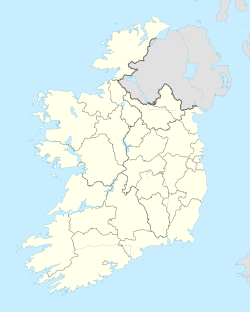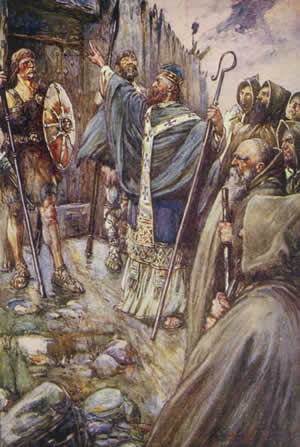
Columba or Colmcille was an Irish abbot and missionary evangelist credited with spreading Christianity in what is today Scotland at the start of the Hiberno-Scottish mission. He founded the important abbey on Iona, which became a dominant religious and political institution in the region for centuries. He is the patron saint of Derry. He was highly regarded by both the Gaels of Dál Riata and the Picts, and is remembered today as a Catholic saint and one of the Twelve Apostles of Ireland.
The village of Hartland, whose parish incorporates the hamlet of Stoke to the west and the village of Meddon in the south, is the most north-westerly settlement in the county of Devon, England.

Draperstown is a village in the Sperrin Mountains in County Londonderry, Northern Ireland. It is situated in the civil parish of Ballinascreen and is part of Mid-Ulster district. It is also part of the Church of Ireland parish of Ballynascreen and the Catholic parish of Ballinascreen, and within the former barony of Loughinsholin.

Skryne or Skreen is a village in County Meath, Ireland. On and around a hill between the N2 and N3 roads, it is 10 km south-east of the centre of Navan and 35 km north-west of the centre of Dublin. The village is on the far side of the Gabhra valley from the Hill of Tara. The Hill of Skryne is higher than the neighbouring Hill of Tara. Skreen gives its name to the surrounding barony, civil parish and townland.

Ballysadare, locally also Ballisodare, is a town in County Sligo, Ireland. It is about 7 km (4 mi) south of Sligo town. The town developed on an important crossing of the Owenmore River. Ballysadare is in a townland and civil parish of the same name.

Cliffoney, officially Cliffony, is a village in north County Sligo, Ireland. It lies on the N15 national route at its junction with the R279. It is only three kilometres away from Mullaghmore which is popular with surfers.

Easky or Easkey is a village in County Sligo, Ireland. It is on the Atlantic coast, 26 miles (42 km) from Sligo and 15 miles (24 km) from Ballina, County Mayo. The village name derives from the Irish language term for fish and Iascaigh literally means "abounding in fish", due to the Easky River that lies adjacent to the village itself. Easky, as a parish, was originally called Imleach Iseal. The area is a tourist destination on account of its scenery and water sports. Easky is a designated area on Ireland's Wild Atlantic Way tourist route.
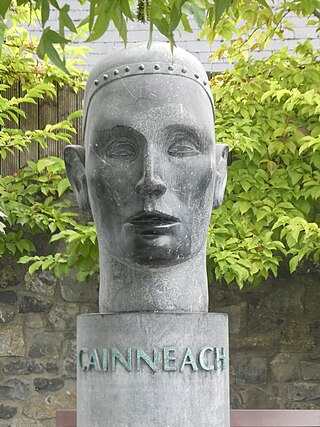
Cainnech of Aghaboe (515/16–600), also known as Saint Canice in Ireland, Saint Kenneth in Scotland, Saint Kenny and in Latin Sanctus Canicus, was an Irish abbot, monastic founder, priest and missionary during the early medieval period. Cainnech is one of the Twelve Apostles of Ireland and preached Christianity across Ireland and to the Picts in Scotland. He wrote a commentary on the Gospels, which for centuries was known as the Glas-Choinnigh or Kenneth's Lock or the Chain of Cainnech.
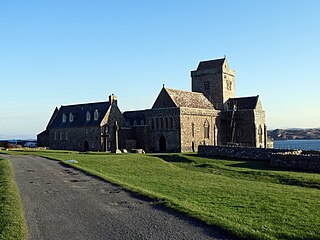
Iona Abbey is an abbey located on the island of Iona, just off the Isle of Mull on the West Coast of Scotland.

Terryglass is a village in County Tipperary, Ireland. The small town is located on the R493 regional road on the north-eastern shore of Lough Derg near where the River Shannon enters the Lough. It is a civil parish in the historical barony of Ormond Lower. It is also an Ecclesiastical parish in the Roman Catholic Diocese of Killaloe,. Terryglass won the Irish Tidy Towns Competition in 1983 and 1997.
Adomnán or Adamnán of Iona, also known as Eunan, was an abbot of Iona Abbey (r. 679–704), hagiographer, statesman, canon jurist, and saint. He was the author of the Life of Columba, probably written between 697 and 700. This biography is by far the most important surviving work written in early-medieval Scotland, and is a vital source for our knowledge of the Picts, and an insight into the life of Iona and the early-medieval Gaelic monk.

Saint Féchín or Féichín, also known as Mo-Ecca, was a 7th-century Irish saint, chiefly remembered as the founder of the monastery at Fore (Fobar), County Westmeath.

Texa is a small island 700 metres directly south of Islay, in the Inner Hebrides, Scotland. It reaches a height of 48 metres at its highest point, Ceann Garbh. It is part of the parish of Kildalton on Islay. The distilleries of Laphroaig and Lagavulin are nearby on the Islay coast, as well as Port Ellen. It is currently inhabited, but is home to wild goats, as well as otters.
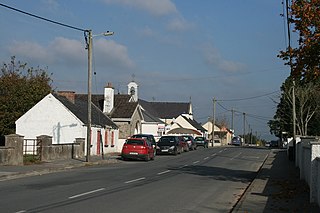
Gortnahoe, also known as Gortnahoo, is a village in County Tipperary, Ireland. It is located on the R689 regional road 6 km (3.7 mi) south of Urlingford, County Kilkenny. It is 3 km (1.9 mi) southeast of the N8 Dublin - Cork road. Gortnahoe, pronounced "Gurt/na/hoo" by the locals, is part of the parish of Gortnahoe–Glengoole.

Hinba is an island in Scotland of uncertain location that was the site of a small monastery associated with the Columban church on Iona. Although a number of details are known about the monastery and its early superiors, and various anecdotes dating from the time of Columba of a mystical nature have survived, modern scholars are divided as to its whereabouts. The source of information about the island is Adomnán's late 7th-century Vita Columbae.
Baithéne mac Brénaind was an Irish monk, one of Saint Columba's followers who accompanied him to Scotland around 563, and was the first successor as Abbot of Iona Abbey. The Annals of Tigernach record his birth in 534, and his death was likely between 596 and 598 according also to the Annals of Ulster. Irish genealogical records indicate him to be the "son of Brendan, son of Fergus, son of Conall Gulban, son of Niall Noígiallach", thus being a member of the Cenél Conaill branch of the Northern Uí Néill, as the abbots of Iona Abbey following the death of Columba often were.

St. James' Church is a former Church of Ireland church in James's Street, Dublin, Ireland. Established in 1707, the corresponding parish, which was separated from that of nearby St. Catherine's, was established in 1710. There had been a shrine dedicated to St. James at nearby St. James's Gate, a stopping-off point for pilgrims, since medieval times. It has been proposed that the current church is near to the site of a church to St. James of Compostella which is first referred to in the mid-13th century.
Cruithnechán, also known as Cruithnechan, Crunathan, and Cronaghan, was an Irish saint from around the 6th century, known as one of the mentors of Columba, who founded the famous monastery at Iona.
The Abbey of Aghaboe is one of the most important of the abbeys and priories in County Laois. It was founded in the kingdom of Osraige by St. Canice in the 6th century. In his Vita Sancti Columbae, Adomnán refers to the abbey, saying that its name means a of the cow: "quod Latine Campulus Bovis dicitur, Scotice vero Achadh-bou"

Skryne Church is a ruined medieval church and National Monument in County Meath, Ireland.

